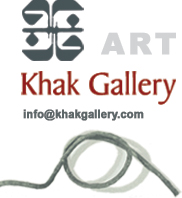
Visit Us
#1 Jila Alley, Basiri St. Gholhak
Shariati Ave. IRAN TEHRAN
TEL: (0098-21) 22 60 54 65
#1 Jila Alley, Basiri St. Gholhak
Shariati Ave. IRAN TEHRAN
TEL: (0098-21) 22 60 54 65
OFFICE
VILLA 21, 4B ST. , AL HUDAIBA 322 -
MARSAM MATTAR ART CENTER
Dubai - United Arab Emirates
SINCERE PRAISE OF BASIC ELEMENTS ( فارسی )
SEND TO A FRIEND!Writen By Helia Darabi
Mehdi Hosseini, a painter, an experienced instructor, and a member of the Iranian Academy of Arts exhibited his new series of work at the Khak Gallery. This exhibition included twenty canvases painted by acrylic and was inspired by Origami or “paper and fold” which is favorite in Japanese hobbies. The shapes made in Origami and their geometric mathematical array catch the attention of the artist, and he has employed them in his recent works. Hosseini who is considered one of the pioneers to combine abstract quality with figurative elements, has paid attention to the ability of these forms to simplify elements of nature to their geometric shapes.He has substituted his past minimalist methods and dissecting figurative elements, with his new approach. Also the range of colours in these works, just like his other works, do not go beyond white, blue and cream.
These works are also evidently tied to line, synchronisation, repetition, interest in breaking down the forms, combining figure and space, perfect execution, and discovering the object’s form by simplifying it, are the main characteristics of his work.
Hosseini was focused on the themes of home, woman, windows, chairs and hands in his past series. He, in different phases of his work, never deviated from his ideals, such as creating visual delight and hidden aesthetics, in the essence of pure painting. Rather he believes in the social influence of deliberate aesthetic art, by means of transforming one’s thought.
In his recent series we can detect complete forms in lower parts of the composition, and their dispersion and scattering along the vertical axis. The joyful dispersion of these components in space is a sort of celebration of simple humble forms that shapes and creates more complicated forms.
Hosseini, with everlasting struggle and joy, continues to find ways of dissecting and connecting the forms with his philosophical world view; as if he is delighted with the salvation of this ancient method by presenting this enjoyment in an obvious gratitude.
In another series of work that do not have Origami content, the signs of Iranian miniature were evident. Mehdi Hosseni’s minimalist trend is a link between Iranian art and Eastern philosophy.
The collection of Zilu-ha, exhibited in the same gallery last year, works had simple geometric patterns of zilu (handmade rugs from Yazd, mostly used for sacred places) and were depicted with the same rural colours of blue and white, but the artist’s unique sky blue. Hosseini honored these inexpensive and ordinary woven rugs, by presenting the designs and colours of these zilus on canvas and hanging them on the gallery walls. He attracted the viewer’s attention to the creativity and thoughts hidden in their designs.
Helia Darabi


